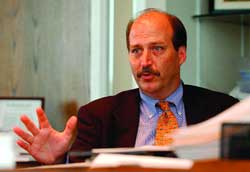Grants services pay off for ACF

Move to online system helps attract more customers.

[HHS was] going to consolidate from seven grants management systems to two. We had to make our case to be one of the two systems.' Wade Horn, ACF
Olivier Douliery
'ACF is the largest grant-making agency in the federal government, outside of the Centers for Medicare and Medicaid Services, so our motivation was somewhat selfish,' Horn said. 'As a part of the one-department strategy, we were going to consolidate from seven grants management systems to two. We had to make our case to be one of the two systems.'
Horn's team not only convinced then-HHS secretary Tommy Thompson that ACF should be a department provider, but also sold the Office of Management and Budget on the idea later that year when the administration asked for proposals for the Grants LOB.
Now, more than a year after being named a shared-services provider for the entire government, ACF is moving to a new online management system, finding success in signing up non-HHS agencies and improving the way it is managing grants while also bringing down costs.
'Our salary and expense costs go down as we bring others on board,' Horn said. 'And costs to the other agencies go down as well as we get more customers.'
Curtis Coy, ACF's deputy assistant secretary, added that the operating costs of the GrantSolutions.gov system decreased to about $3.2 million from $5 million for the previous Grants Administration Tracking and Evaluation System (GATES) since becoming a shared-services provider.
Horn said that the savings from taking on new customers let ACF keep 20 people working on mission-critical projects.
'HHS has had to downsize in recent years so, without that $2 million, there would be 20 fewer people on staff,' he said.
ACF has 14 customers within HHS, including CMS and the Office of Public Health and Science, as well as three agencies from outside ' the Agriculture Department's Food Safety and Inspection Service, Treasury's Community Development Financial Institutions and the Denali Commission.
Coy said that, on average, agencies pay about $200 per transaction to cover operating costs and maintenance of the system.
ACF's costs will continue to drop and the management of grants will improve as more and more agency customers use the Web version of GrantSolutions.gov.
Coy said agency customers started migrating last month and will continue into 2008.
ACF spent about $2 million to upgrade the discretionary award module from client-server technology to one using Java 2 Enterprise Edition.
The agency upgraded the other parts of the GrantSolutions.gov system using J2EE in 2004.
'The investment was two-fold. We took pieces of the old system and used existing technology from HHS bureaus to develop the new system,' Coy said. 'We had to go to a Web-based system because half of our users are in our 10 regional offices around the country.'
GrantSolutions.gov is a dual environment of Sun Solaris and Compaq servers running Unix. The front end of the system is built on a Struts J2EE framework and all data is stored on an Oracle 10g database.
Struts is an open-source framework for developing J2EE Web applications.
HHS hired RNSolutions Inc. of Rockville, Md., and Synectics for Management Decisions Inc. of Arlington, Va., to support the system and its upgrade.
Coy said the biggest technical challenge with the new system has been aligning legacy data structures with the new data fields to ensure that workflow and other functions work. ACF spent about $200,000 to migrate data to the new system.
'We must do this while all systems are running and [while] a new partner is being added each quarter with a new set of strategic business requirements that we must be sure to meet,' Coy said.
ACF's new system has made it easier to generate reports and it has speeded up the process to award grants, said Lois Hodge, director of division grants operation and a grants management officer for HHS' Indian Health Service.
HHS, which has been a customer of ACF since 2004, is paying more to use the GrantSolutions.gov system than its old one, Hodge said. But she said the improved functionality makes it worth it.
'We are able to generate reports on our own instead of relying on the contractor,' she said. 'Application receipt happens in a matter of minutes instead of a day or two. The new system can be used by the program office as well.'
Horn said another advantage of the new system is that it can do any type of grant processing'discretionary, entitlement, block or R&D.
'When OMB came out with the LOB, there were 14 business processes they wanted providers to meet,' Horn said. 'We were the only ones to meet all 14.'
Coy said another benefit of GrantSolutions.gov is that it interfaces with HHS' Payment Management System, which disbursed 70 percent of all civilian grants in fiscal 2004.
The Chief Financial Officers Council selected PMS as one of the two non-Defense grants payment systems for the entire government. 'Agencies have been hesitant to migrate because of the normal resist-change issues,' Horn said. 'But I think things may change in 2007, especially since we are now Web-based.'
NEXT STORY: GSA vows to avoid FTS-2001 mistakes





